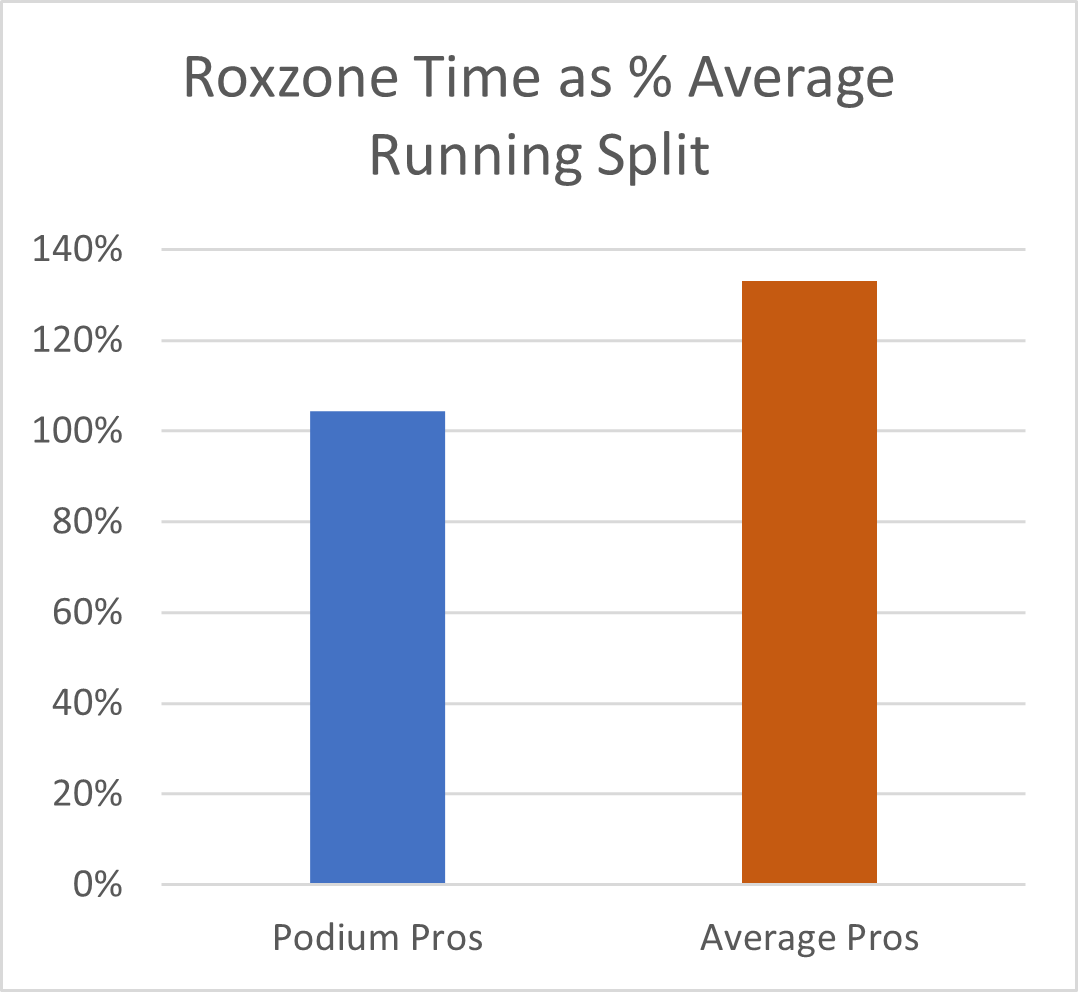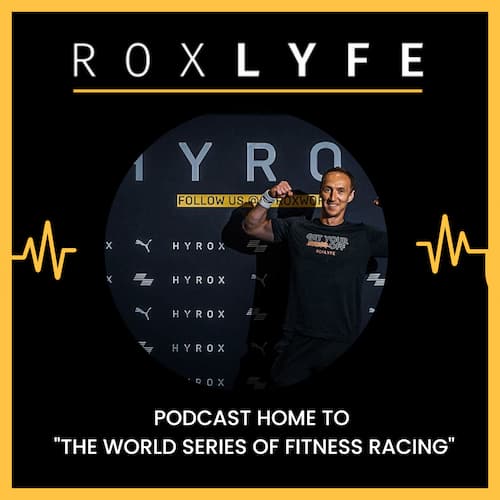As you’ll know if you’ve been following this site, and our Instagram, for a while, I’m a bit of a HYROX data geek. I love getting into the numbers to see if it can reveal anything about how to improve our performance in the sport.
In this post, I will summarise what I think are some of the most interesting and useful bits of information I’ve uncovered so far, and discuss how they can help you improve your performance in the event.
Let’s get into it…
#1. Roxzone Time
In our “Average to Elite” article, I noticed that those who had achieved some of the best ever times at HYROX seemed to spend less time in the Roxzone, relative to those who achieved a more average time.
As a further example of that in action, the graph below compares the differences between the 6 Pros (3 men, 3 women) who reached the podium in London 2022, and 6 Pros who achieved an average (but still very respectable!) time of around 90mins at the same event…

On average, the Podium Pros spent 104% of their average running split times in the Roxzone, whereas the Average Pros were 133%.
To put that in context, with an average example running split of 5:00mins, an additional 29% equates to an extra 1:27mins in the Roxzone (which is significant).
To summarise, if you want to go fast, don’t spend longer than needed in the Roxzone!
(note, if you arent sure what the Roxzone is, check out this video on our YouTube channel).
#2. Consistent Pacing
The difference between how the Elite and an average athlete paces their runs, I personally found quite surprising…
In our “How to pace your running at Hyrox” article, we noted that the Elite racers at the 2022 HYROX World Championships in Las Vegas seemed to run much more consistent running splits than an average athlete (who is still of a very good standard!) on the same day.
I figured that the World Championships may have been an anomaly. So for the purposes of this article, I double checked. Looking at the same groups of athletes mentioned in the Roxzone section above, we can see the following median time differentials…

Once again, those who performed best overall ran much more consistent splits. The Podium Pros had a median difference between their fastest and slowest runs of just 17 seconds. Whereas it was twice that for the Average Pros. This backs up what we saw at the World Championships.
(Note: I’ve only looked at runs 2 to 7, as runs 1 and 8 can be different in length).
For more on running pacing, check out this article.
#3. Sled Push Getting Harder
The difference in the sled push performance times, from venue to venue, is very interesting.
To give an example, the graph below shows the median of the top 10 sled push times for each of the first 3 European events of the 21/22 season, and the last 3 events of the season…

It shows that the times have been getting much slower, despite, in general, the standard of athlete competing in HYROX appearing to have improved. It’s as if the sleds are becoming harder to push.
I discuss possible reasons why this may be in this article, but the question becomes what can we do about it? We obviously can’t change the sleds that we push – we just need to deal with what we’re given on the day. So, here’s a few pieces of advice that I feel are important:
– We know that the sleds aren’t consistent, so expect the unexpected. This way, you won’t allow the increased difficulty of the sleds (if it comes) to mentally affect you during the race. It’s probably better to be expecting something incredibly heavy, and finding yourself pleasantly surprised, than vice versa.
– Train regularly with a heavier weight than you’re expecting to encounter in the race. This way you’ll be more prepared, mentally and physically, to move it on the day.
– Ensure you have the right footwear. Pushing a heavy sled in the wrong footwear can make things VERY hard. We discuss that more in this article on the right footwear for HYROX.
– Practice with differing techniques for pushing the sled. The type of sled, the carpet, and the weight, may make one technique more appropriate on the day. I talk about some of these techniques in this sled push article.
#4. Sled Pull to Sled Push Ratio
In our “Average to Elite” article, we noted that the best of the best in HYROX appeared to have a much slower Sled Pull to Sled Push Ratio than the Average athlete. Put another way, their sled push and sled pull times were much more closely related. Whereas the Average athlete was going relatively fast on the Sled Push, and much slower on the Sled Pull.

I initially looked at this ratio because these are the 2 main stations in HYROX that have a strength demand. Therefore, whatever your strength levels I felt you’d perform relatively the same on those stations.
The differences here made me reach two possible conclusions. Either (a) the average person needed to work more on their sled pull technique, or (b) the average person was pushing too hard on the sled push, relative to their overall abilities.
In the HYROX events I’ve taken part in since reaching these conclusions, I have certainly paced myself more on the sled push, understanding that I don’t need to complete it as quickly as possible. If you go too fast on the sled push, your legs can turn to jelly, making the rest of the race a LOT harder. So now I pace more effectively and deliberately hold myself back a little. I also did a lot of work on my sled pull technique in training. Both these changes have broadly aligned my sled pull / sled push ratio with that of the Elite athletes.
Check out this article for tips on improving your Sled Pull.
#5. Ski and Row
Any time I have looked into the data it has almost always shown that someone’s ability on the Ski or Rowing station is not of a huge importance in reducing their overall finishing time. Of course, all elements of the race are important to some extent, but these are normally the lowest priority. They are the areas where we see the smallest variation in times between the Elite and the more average athlete.
As an example, if we look at the Ski and Row times for the 12 athletes mentioned above from London 22, we can see the following (relatively small) time differences in the performances on those stations…

So yes, the Podium Pros were faster than the Average Pros. However, the differences were just 18 seconds on the Ski, and 31 seconds on the Row. In the context of a full HYROX that is a relatively small time difference.
Understanding this helps you to prioritise what you need to be focusing on in training. I certainly still do train on the Ski and Row (as mentioned in this HYROX training article), but it doesn’t have as high a priority as other elements of the race.
I’m also careful to pace myself on those stations and am happy to deliberately go a few seconds slower than some of the other athletes. I’m not great on the Ski but I know, for example, that if I go just 5 secs / 500m faster than my normal race pace, it can have quite a significant effect on my heart rate and would potentially adversely impact other elements of my race.
So, with those pieces of knowledge combined, I feel I now pace myself much more effectively on those stations and it improves my overall performance.
To find out which stations are a priority for you to be working on for your next HYROX, then check out this article where we guide you on achieving your target time.












